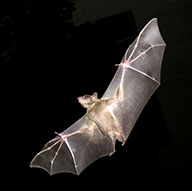Mammal Of The Month: May 2017
Bats are the Hidden Heroes of Mammalia

Credit: Wikimedia Commons
May 4, 2017
The main goal here at the Mammal of the Month writer’s desk is to shine a light into all corners of the mammal community and improve the reputation of the most underrated. On this note, get ready to learn all about bats and how great these creatures really are.
First off, bats are huge. Not in size, although some are, and we’ll certainly come back to that, but in population. What really qualifies an animal as a bat is that they’re in the order Chiroptera, which is absolutely massive. Aside from the order Rodentia, or rodents, the order of bats have the largest population in the mammal community, making up about 20% of all mammals. That’s right, one out of five mammals is a bat.
Variety goes hand in hand with their numbers, and as of now there are about 1,240 discovered species of bats. And with all these varieties, bats can’t be expected to stay in the same place. Bats live almost everywhere in the world, except for cold regions. Each species lives in different places based on their diet and other natural factors, but there is a good chance a bat lives on your property, or at least in your neighborhood.
Many bats feed only on insects, and most of the rest feed on fruit. Bats that feed on fruit are actually called megabats, and are nicknamed “flying foxes”. There’s also a fish-eating bat, and of course the infamous vampire bat, which feeds on blood. There are actually three species of vampire bat, but they’re native to Mexico and South America.
So now that we’ve gotten the technical stuff out of the way, let’s talk about what makes bats such important and interesting creatures. Bats are trailblazers. As of right now, and forever before, bats are the only mammals that actually fly. But what about flying squirrels? Nope, they glide. Bats are the only mammals that flap their wings and power their own flight.
Similar to flying insects like bees and birds, bats keep earth green through pollination and the spread of seeds. They also eat small pesky insects, reducing the need for pesticides and keeping it natural. Another impressive feature of the bat is it’s size. More specifically, the wide range of sizes. With 1,240 species, variation shows itself once more. The fruit-eating megabats have the largest sizes, as their name suggests. A bat in this sub-order, the giant golden-crowned flying fox, can reach wingspans of over 5 and a half feet. But bats can also be very tiny. Kitti’s hog-nosed bats, commonly known as bumblebee bats, are the world’s smallest bats, and might even be the world’s smallest mammal. Now that’s diversity. Their wingspans average 1.4 inches.
Bats are important because they’re important to you. With their massive variety and populations, pest-eating habits, and trailblazing for the rest of the mammal community, bats work tirelessly behind the scenes to ensure a worry-free and relaxed existence for the rest of us. So next time you feel grateful, take a quiet nighttime stroll and thank your friendly neighborhood bat.








